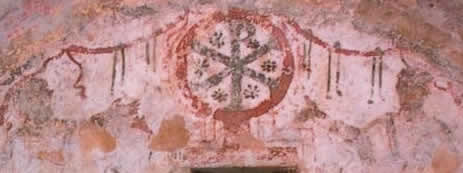












|
|
3rd Conference of the Hungarian Patristic Society on
Ancient Christianity
East and West:
Unity and Plurality in the Early Church
Scholae Piae, Kecskemét,
26-29 June, 2003.
[This page is under construction. For
English/French/German/Italian titles of
papers see the abstracts, where available {click on title}]
26th June, Thursday
15.45. Inauguration – Dósai Attila SP
16.00-17.00
Chair: Adamik Tamás
Inauguration lecture
Baán István: Singidunumi Ursacius és Mursai Valens, az arianizmus pannóniai
képviselôi
17.00-18.00
Pesthy Monika: Beliár három hálója
Geréby György: A platonikus bozót. Nyelv, szimbolika és vallási identitás a
II-III. században
18.15 Concert
27th June, Friday
9.00-12.30 Papers
Chair: Perczel István
9.00-10.00
Adamik Tamás: Simon mágus és az Apophaszisz megalé
Frenyó Zoltán: Az ókeresztény asztrológia-kritika tendenciái
10.00-11.00
Odrobina László: A sokféleségtôl az egység felé: az ókori zsinatok vegyes
házasságokat szabályozó rendelkezései
Rihmer Zoltán: A szír-római jogkönyv L 106-os helyének két egyházi párhuzama
11.30-12.30
Szuromi Szabolcs Anzelm: A Canones apostolici mint a keleti és a nyugati
egyházak közös jogforrása
Orosz Athanáz: Erôsíthették-e a Kelet-Nyugat közötti egyházfegyelmi
különbözôségek az ókeresztény egyház egységét?
13.00 Lunch
15.00-18.30 Papers
Chair: Pesthy Monika
15.00-16.00
Havas László: Keresztény és pogány uralkodói tükör Keleten és Nyugaton a Kr.
u. IV-V. század fordulóján
Jakab Attila: Kelet és Nyugat között. Mítosz és valóság a román ortodox
történetírásban
16.00-17.00
Rászlai Tibor: A Khalkedóni Zsinat legfontosabb szövege sorról sorra
Nagy Kornél: A 862-es sirakavani zsinat: Khalkedón utóhatása a kora-középkori
Örményországban
17.30-19.00
N. Hudák Krisztina: A pécsi Szt. Péter és Pál sírkamra ikonográfiai programja
Terdik Szilveszter: Angyali hierarchiák ikonográfiája a középkori keleti és
nyugati hagyományban
Sándor Balázs: Sokféleség szülte egység
19.15 Dinner
20.00 General Assembly of the Hungarian Patristic Society
28th June, Saturday
9.00-12.30. Papers
Chair: Bugár István
9.00-10.00
Perczel István: Az istenismeret útja keleten és nyugaton
Tóth Péter: Szenvedélytelenség vagy lelki egészség? Az apatheia terminusának
történetéhez
10.00-11.00
Peres Imre: Az apostoli atyák missziós törekvései
Perendy László: Irenaeus a katolikus
11.30-12.30
Kendeffy Gábor: Lactantius és a görög egyházatyák
Boros István: A Szentlélek származása Nüsszai Szent Gergelynél és Szent
Ambrusnál
13.00 Lunch
15.00-18.30 Papers
Chair: Kendeffy Gábor
15.00-16.00
Ivancsó István: Nagy Szent Bazil alakja a bizánci egyház liturgikus
szövegeiben
Kormos József: A teológia filozófiai megközelítésének két lehetséges útja. A
„misztikus” Dionysius Areopagita és a „skolasztikus” Boethius
16.00-17.00
Németh Csaba: Eriugena és tradíciója
Majorossy Imre Gábor: „Vesd ki palotádból ellenségeidet” – A hit átadásának
elsô lépése a Barlaam és Jozafát-történetben
17.30-18.30
Bugár István: Veronika és Bereniké: az elsô nem
kézzel készült képmások
Luft Ulrich: Az eikón a gnosztikus felfogásban
19.00 Dinner
29th June, Sunday
Closing address - Nemeshegyi Péter SI.

|
ABSTRACTS
Zoltán Frenyó, Saint
Augustine and the tendencies of the patristic critique of astrology.
In opposite of the tipically ambiguous antic
attitude towards astrology, the whole patristic thinking refuses this way of
thinking. The Church Fathers make a difference between astrology and astronomy:
they fight against astrology and appreciate astronomy in their culture. In the
thinking of Origen astronomy has a great value: it is an introduction into the
Scripture. Against astrology he emphasizes the role of the human free will.
Saint Augustine developes a complete critique of astrology, while he reconciles
the divine providence and determination with human free will and responsability.
István Bugár:
Veronika and Bereniké: the first images not-made-by-human-hands
The concept of images not-made-by-human-hands had
originally an apologetic goal and was to convey in principle two messages. First,
they were to defend images against the claim that they were fashioned violating
the commandments of the Old Testament, which -- together with a certain line in
Greek philosophical tradition -- criticized in cultic images the fact of human
making.
Second, the miraculous origin of such images was to prove their authenticity,
and the authenticity of similar images in general. In my paper, visiting
the first known Christian images not-made-by-human-hands (the portrait of Edessa
and the one mentioned in the Mors Pilati), I argue that as the development of
Christian cultic at is parallel in the East and the West in Late Antique times, so the
idea of images not-made-by-human hands appears simultaneously in the Latin and the Greek-Oriental
world. I propose that the chapters of Egeria's Diary concerning Edessa allow us to
have a glance at the first stages of the development of the traditions about the famous portrait.
If my interpretation of her curious -- and thus far ignored -- hapax legomenon
((archiotipam, or archiotepam) is correct, then it refers to the face of
king Abgar seen in the natural pattern of the marble in his palace, which was at some later
point interpreted as a portrait of Christ, and related to an other ancient image preserved
in Edessa and mentioned in the Doctrina Addai. This explanation would square with
the interpretation of the famous line in the inauguration anthem of the cathedral of Edessa proposed by Andrew Palmer.
|
|



